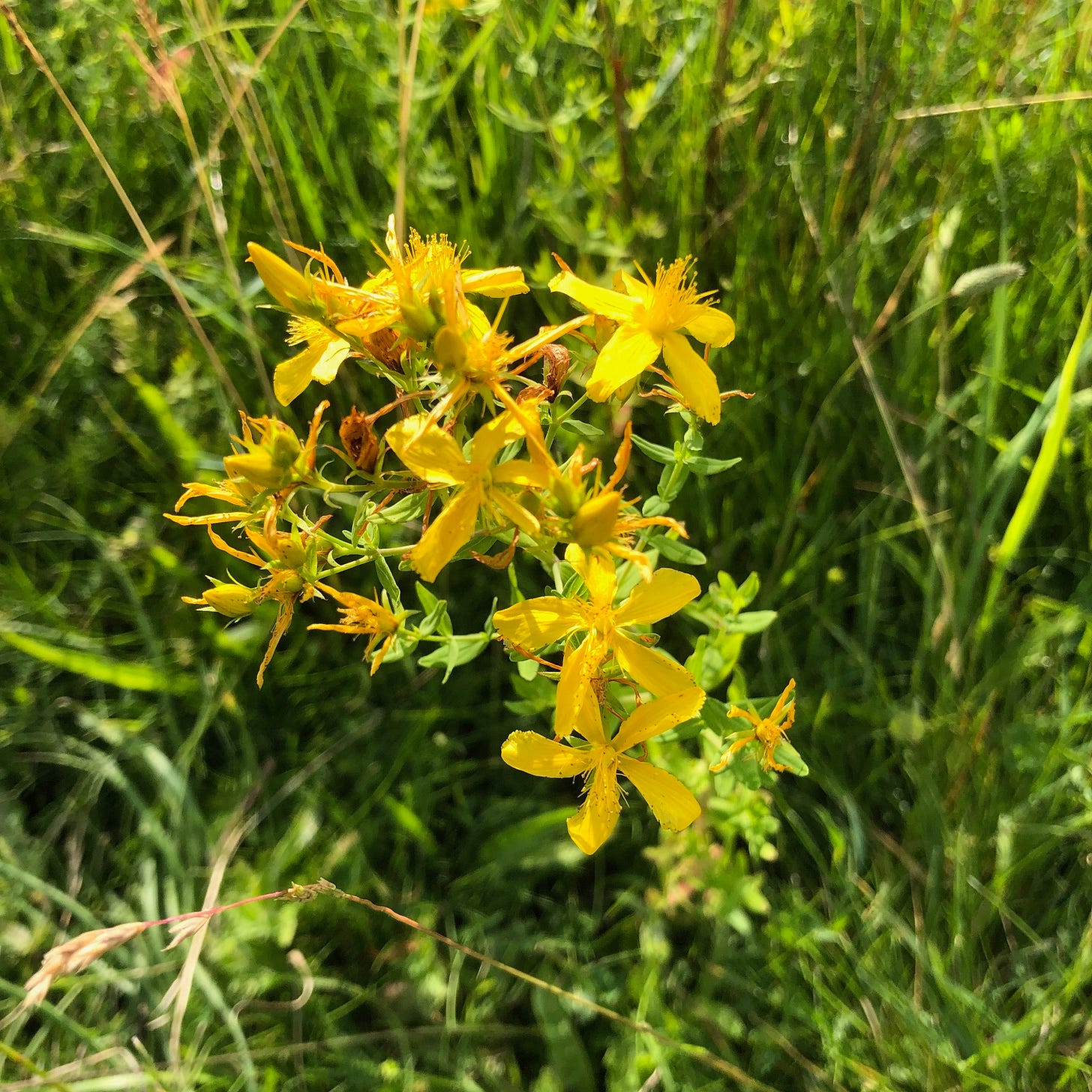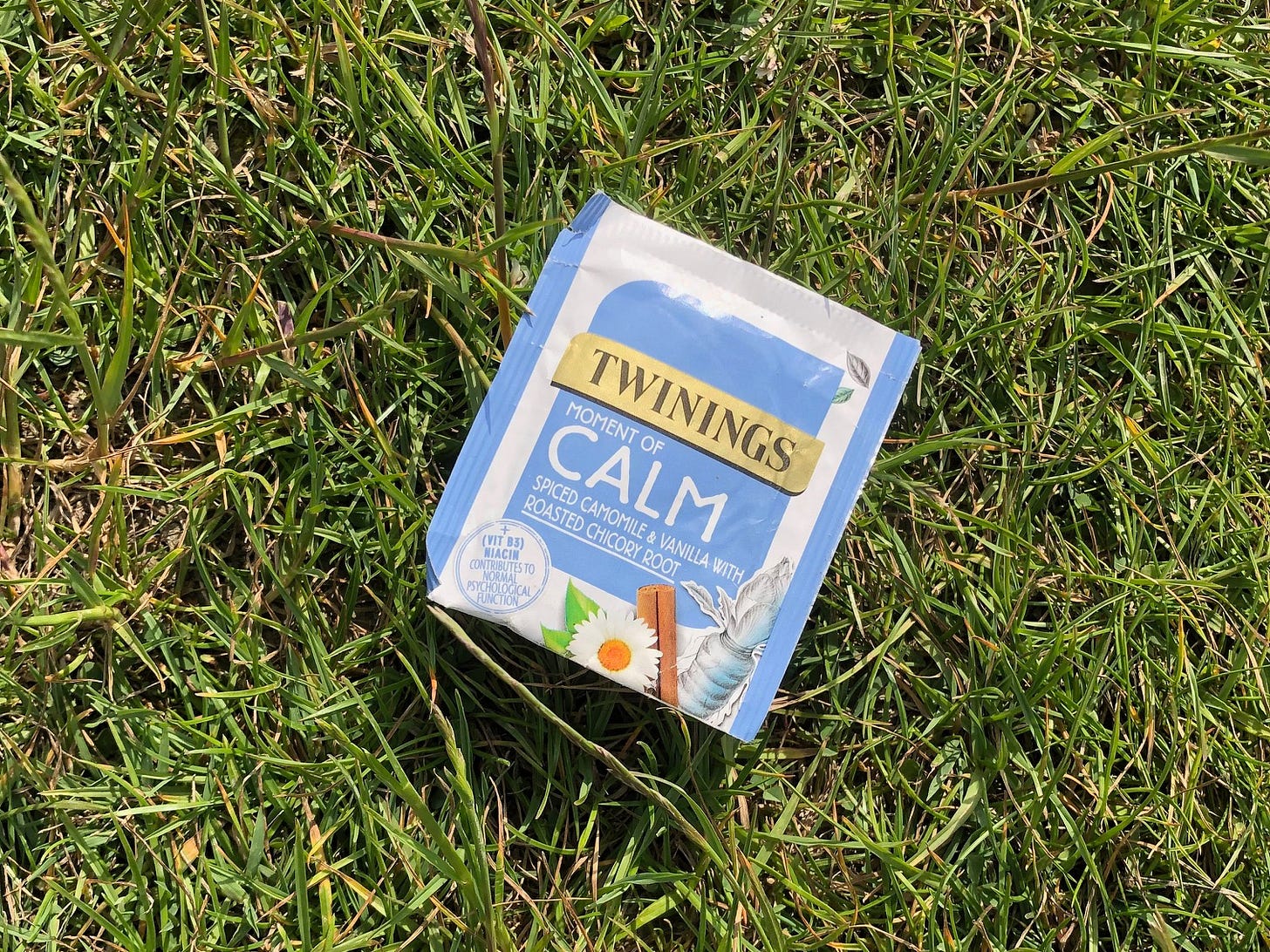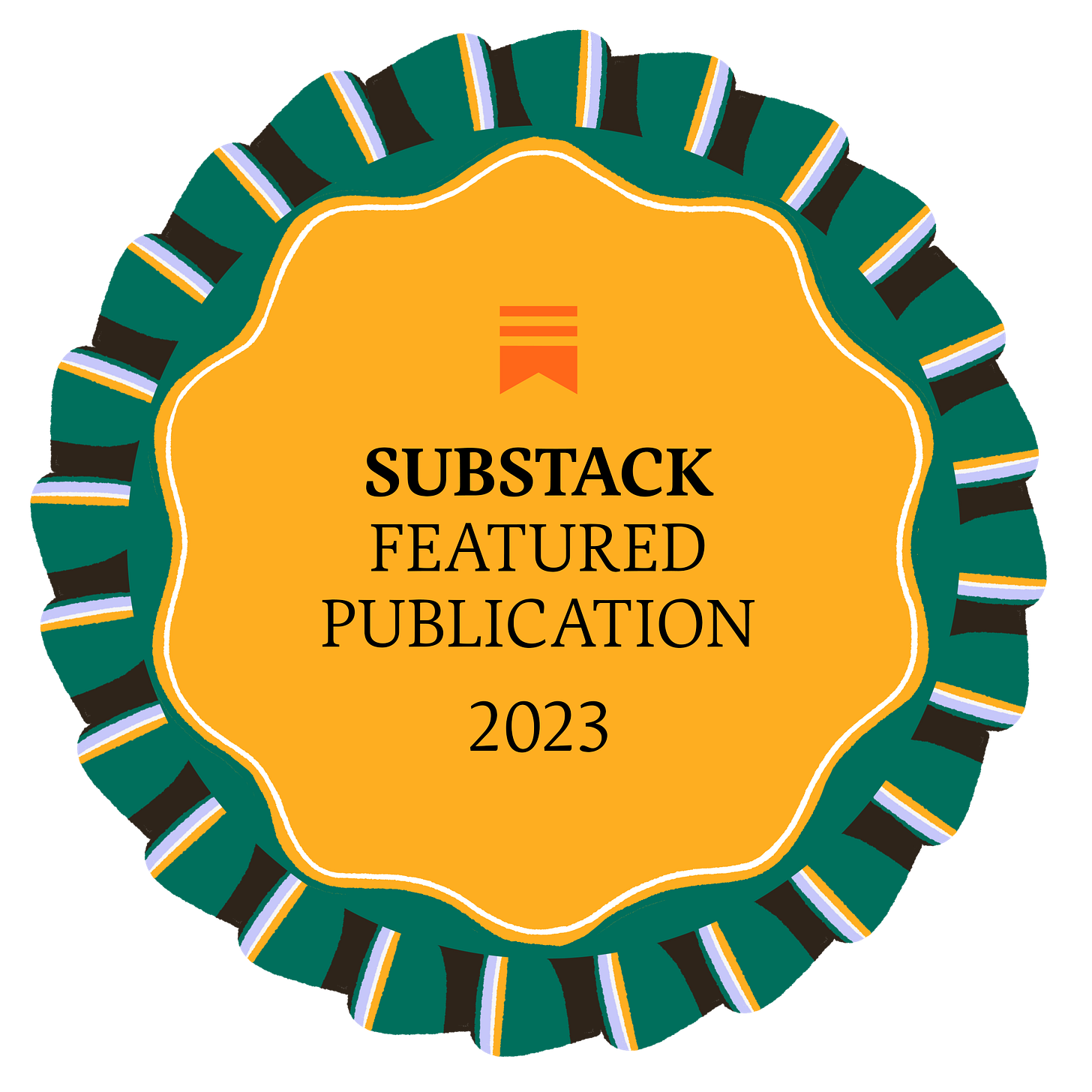Dear Reader,
On a rare trip to London last month I was told by a complete stranger to calm down. This has never happened to me before: in the company of others I have always been on my best behaviour1, and I like to think that it is only when I let my guard down in the company of those I love and trust that I come across as anything other than calm.

This was new.
I love to walk: for me there’s nothing better than striding along a footpath on a solo expedition. For most of last year I walked every day, sometimes for minutes, often for hours, and occasionally my rucksack, tea flask, notebook and I would be gone all day.
Yet at the start of the autumn I was slowing down, not really striding as boldly as I used to. I’d changed down a gear, or maybe even two. I didn’t feel like me. My clothes were tighter; I was less relaxed, more anxious, less calm.
Brought to my senses in a conversation in the comments of Sharron Bassano’s2 wonderfully titled post ‘Macaroni and cheese on top of a baked potato with a side order of toast’ on Wednesday last, I took the opportunity to head out for a walk in the Chiltern hills on Thursday while my hardworking husband stayed in the van to edit pictures from the job he had shot that morning.
‘Don’t overdo it!’ he warned me as I put my boots on. ‘You haven’t been for a walk for ages, remember.’
Reader, I remember. This time last year I was fit as a flea, but when in October the weather changed and heavy rain began to soak our summer-parched lawn back to life, I found it harder to even want to spend time outside.
Last autumn, rain fell every day and night for weeks, and then it was cold, and then it was Christmas, and after that it was still winter… and by the time the sun had come out and the days began to lengthen I not only didn’t feel like exercising, I’d got out of the habit of moving altogether.
There was a keen wind, but the cloud-free Thursday afternoon in June demanded sunhat and shorts, and I took care to tie on my blue bandana to protect the bare skin of my neck.
The OS Maps app showed me the way: my route would take me straight down the driveway of the campsite and across a busy main road. It would be straight on across a field from there, and then where the land began to rise steeply in front of me I would pass through the field boundary and take a sharp left to head towards Ivinghoe Beacon.
Since we’d arrived at the campsite a couple of hours earlier, the sparsely tent-freckled field alongside the driveway had grown a sudden rash of additional dwellings to become a temporary town of tiny tents.
Minibuses sign-written with the names of schools and their erudite slogans were parked beside tight knots of one-man tents: familiar motherships to the teenage inhabitants of their nestling smaller craft.
The field in question wasn’t part of the main campsite; instead, it was set aside solely for the use of participants of the Duke of Edinburgh’s Award Scheme3, for whom an expedition is part of the curriculum for bronze, silver and gold awards alike. Not for them the mains water taps, the washing-up facilities or – poor things – the beautifully-appointed washrooms with piping hot showers of the main site; no, they had water bowsers and chemical loos.
Here’s what the DofE expects from their participants of the Expedition components:
For your Expedition section, you will need to plan, train for and complete an unaccompanied, self-reliant expedition with an agreed aim. You must do the correct training for your level and mode of travel, at least one practice expedition, a qualifying expedition (the one that is assessed) and a final presentation in order to complete the section.
Your expedition must be completed by your own physical efforts (but you have loads of choices, not just on foot!) with minimal external intervention and without motorised assistance. Your route should also be a continuous journey.
Having reached the end of the driveway I stopped to cross the road, and once I was through the gate on the other side, something caught my eye.
It was a small square of blue and white paper. A band of gold across it caught the sunlight, so at first I couldn’t see the brand name contained within it, but I could read the word ‘CALM’ loud and clear.
Calm.
What was this little square of calm? And why was it lying on the path just where I was about to walk?
The piece of fluttery flotsam was a tea bag, perhaps dropped from a walker’s rucksack. Would they miss it, I wondered? Would they be boiling up a billycan of water right now, hunting in vain for their cup of calm to soothe their tired brain as their hardworking muscles eased into rest?
Although used in the vernacular to mean odds and ends, rubbish or waste, flotsam and jetsam are in fact terms that describe two types of marine debris associated with vessels. Flotsam is defined as debris in the water that was not deliberately thrown overboard, often as a result from a shipwreck or accident. Jetsam describes debris that was deliberately thrown overboard by a crew of a ship in distress, most often to lighten the ship's load. The word flotsam derives from the French word flotter, to float. Jetsam is a shortened word for jettison.4
My mind went into overdrive. ‘Calm is what you NEED!’ it told me. ‘Perhaps this isn’t flotsam, but jetsam – maybe someone has jettisoned it on purpose for you to find.’
Looking around me in case somebody was watching, I bent down and picked up my light-as-air treasure, stowing the teabag talisman between my pocket notebook and its leather cover.
TWININGS
MOMENT OF CALM
SPICED CAMOMILE & VANILLA WITH ROASTED CHICORY ROOT
+
(Vit B3)
NIACIN
CONTRIBUTES TO
NORMAL PSYCHOLOGICAL FUNCTION
Wow! I was striding the trails again for the sake of my physiological function, but to be delivered a moment of calm in the process – and one that would contribute to my psychological function – well, this was amazing.
The universe had been listening.
Once I’d reached the far end of a much-longer-than-it-looked field of ripening barley, I passed through a pedestrian gate. A cacophony of voices hit me, but I couldn’t see the source. My OS Maps app told me that I could turn left or right at this point, along the very bottom of the ridge of hills, but this incongruous sound was coming from straight ahead of me, high up, where no footpath was marked.
I heard a shriek. Then: ‘DON’T!!!!!!!!’ I looked up. Careering down the slope at high speed was a chaotic mishmash of waving arms, legs in shorts, scattered sunhats and overstuffed rucksacks.
I could hear laughing. No bones audibly snapped.
‘It’s right there, look!’ said one of the gangly teenagers to a smaller companion. ‘Told you we’d be much quicker this way!’ In a flash they had passed me, heading straight for the campsite.
I smiled to myself and shook my head. I felt a hundred years old.
Grateful to not be the subject of any DofE assessment of my own navigational (in)capabilities, I followed the trail shown on my OS Maps app. The grass around me was green, and to my delight it was studded with the sorts of floral treasures that I’d come across while Jim had been shooting ‘Meadow’.
Suddenly I was reliving those eighteen wonderful months of on-and-off vanning to far-flung corners of the British Isles for Jim’s book.
It hadn’t all been shorts and sunhats on that project, though; there were plenty of dawn shoots in frost and snow, including one memorable occasion when the icicles hanging from the tailgate of the van had grown so long that they’d frozen it to the ground.
But now, in the Chilterns in high summer, meadow plants were in full bloom.





Pyramidal orchid, greater knapweed, meadow goatsbeard, field scabious and hawkbit had long since been ticked off on my checklist of meadow flowers, but a prickly little pink number had me guessing.
Diving into the ‘Seek’ app, I found it to be spiny restharrow, a plant I’d never heard of, let alone ever seen.
Naturespot tells me that spiny restharrow is ‘fairly frequent in much of England’, while Plant Atlas claims it to be ‘rare or scarce in Great Britain’. Well, whatever the experts’ opinion, this amateur flower-bagger had never ticked it off her list.
The whole time I spent photographing and identifying flowers I could hear voices of tired teenagers at the top of the ridge, and a few passed me in groups of twos and threes, heading in the direction from which I’d come, towards the campsite. After a long pause in fellow foot traffic, a preoccupied-looking teenage girl in a red t-shirt passed me slowly in the other direction, and a moment later I heard several voices calling a girl’s name repeatedly.
Soon after, another teenage girl, this one in a black t-shirt, hurried up to me. ‘Have you seen a girl in a red top?’ she asked, breathless. ‘Yes’, I replied. ‘Just now. She’s on this path, too – you’ll catch her up in a couple of minutes!’
Reader, this felt very familiar. And as someone so entrenched in the disorientating landscape of lost, I was worried about that first girl.
Preoccupied red-t-shirt-girl – me.
Concerned black-t-shirt-girl – any one of the friends I’d ever been separated from on a journey.
I was suddenly grateful that I’d had people looking out for me at that age, too, and for a moment I was a preoccupied teenage girl again myself.
One with damp eyes.
A few minutes later, while I was consulting the Seek app to identify another plant I didn’t know, both girls passed me the other way. This time they were together.
‘Thanks!’ they said in unison. I smiled at them. ‘Well done!’
Anxiety assuaged, I glanced down at my phone, still wiping my eyes. This was the plant I’d been looking at:
St John’s wort.
That’s right: another source of calm, but this one plumbed into the ground, not formatted into a tea bag.
St John's wort helps the brain use the neurotransmitters (chemical messengers) serotonin, dopamine, gamma-Aminobutyric acid (GABA), and norepinephrine more effectively. This can lead to feelings of overall wellbeing and happiness, and may reduce symptoms of anxiety.
Taken from Healthline.com
Even without recourse to St John’s wort from a herbalist, or to boiling the kettle and sampling the soothing nectar of my teabag flotsam, the message on my piece of lucky litter remains.
A moment of calm can be found even when we’re not looking for it.
Love,
Rebecca
EXCITING NEWS!
🥳
I was thrilled last Saturday afternoon to find that
had become a Featured Publication on Substack Reads, thanks to a very kind nomination from !As a result, I’ve welcomed a number of subscribers – a big thank you to all my new readers. ♥️ And those of longer standing? I love you, too! ♥️
Thank you so much for supporting Dear Reader, I'm lost. I’m thrilled that you’re reading my words. 😘
It’s not just a tea bag that I’ve found in the wild! This post introduces my penchant for picking up interesting things on my travels:
73. A lost list
Dear Reader, At the end of a very long day on Wednesday, which Jim had spent shooting a family-orientated event during the busy school half term holiday, I walked across the empty lawn to fetch some gear that I needed to pack away. Earlier in the day the location had been packed: there had been fairground rides, sideshows, circus skills workshops and all…
If you enjoyed this post, please let me know by clicking the heart. Thank you!
If you’ve been following my correspondence with my fellow Substacker Terry Freedman you’ll know that it’s my turn to reply to him on Wednesday! You can find the index for our entire canon of letters here. Do have a read of our light-hearted exchanges about British life over our shoulders!
My next ‘Dear Reader, I’m lost’ post will of course be published next Saturday.
Thank you for reading! If you enjoy ‘Dear Reader, I’m lost’, please share and subscribe for free.
mostly 😉
NOAA. What are flotsam and jetsam? National Ocean Service website, https://oceanservice.noaa.gov/facts/flotsam-jetsam.html, 12/06/23















So lovely seeing that badge in this post! You deserve it!
As. a lover of peace and calm, and yet not a hippie, I so enjoyed this post.
Exhausted from husband's and self's adventure thus far, and with intermittent WiFi, just quickly - I rather like the look of Jim's book and must seek it out, I drink camomile tea and I also take St.J's Wort capsules. Even better, my dog takes CBD Oil. We're one calm family - on paper!